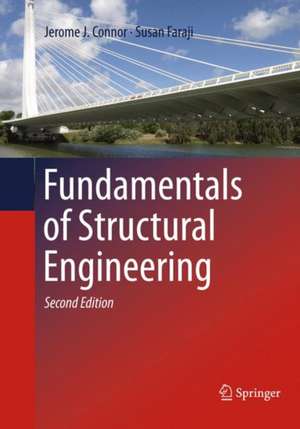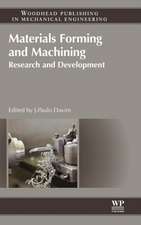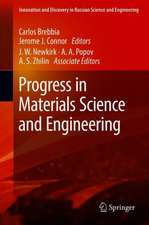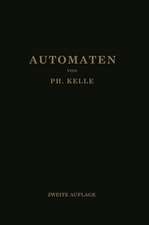Fundamentals of Structural Engineering
Autor Jerome J. Connor, Susan Farajien Limba Engleză Paperback – 7 apr 2018
The book fosters an intuitive understanding of structural behavior based on problem solving experience for students of civil engineering and architecture who have been exposed to the basic concepts of engineering mechanics and mechanics of materials. Distinct from other undergraduate textbooks, the authors of Fundamentals of Structural Engineering, 2/e embrace the notion that engineers reason about behavior using simple models and intuition they acquire through problem solving. The perspective adopted in this text therefore develops this type of intuition by presenting extensive, realistic problems and case studies together with computer simulation, allowing for rapid exploration of how a structure responds to changes in geometry and physical parameters. The integrated approach employed in Fundamentals of Structural Engineering, 2/e make it an ideal instructional resource for students and a comprehensive, authoritative reference for practitioners of civil and structural engineering.
Toate formatele și edițiile
| Toate formatele și edițiile | Preț | Express |
|---|---|---|
| Paperback (1) | 582.81 lei 38-44 zile | |
| Springer International Publishing – 7 apr 2018 | 582.81 lei 38-44 zile | |
| Hardback (1) | 745.73 lei 38-44 zile | |
| Springer International Publishing – 2 mar 2016 | 745.73 lei 38-44 zile |
Preț: 582.81 lei
Preț vechi: 719.52 lei
-19% Nou
Puncte Express: 874
Preț estimativ în valută:
111.54€ • 116.01$ • 92.08£
111.54€ • 116.01$ • 92.08£
Carte tipărită la comandă
Livrare economică 10-16 aprilie
Preluare comenzi: 021 569.72.76
Specificații
ISBN-13: 9783319796031
ISBN-10: 3319796038
Pagini: 1050
Ilustrații: XXVII, 1050 p. 900 illus., 146 illus. in color.
Dimensiuni: 178 x 254 mm
Greutate: 2.13 kg
Ediția:Softcover reprint of the original 2nd ed. 2016
Editura: Springer International Publishing
Colecția Springer
Locul publicării:Cham, Switzerland
ISBN-10: 3319796038
Pagini: 1050
Ilustrații: XXVII, 1050 p. 900 illus., 146 illus. in color.
Dimensiuni: 178 x 254 mm
Greutate: 2.13 kg
Ediția:Softcover reprint of the original 2nd ed. 2016
Editura: Springer International Publishing
Colecția Springer
Locul publicării:Cham, Switzerland
Cuprins
Part I - Statically Determinate Structures.- 1.Introduction to Structural Engineering.- 2.Statically Determinate Truss Structures.- 3.Statically Determinate Beams.- 4.Statically Determinate Plane Frames.- 5. Cable Structures.- 6.Statically Determinate Curved Members.- 7.Shallow Foundations.- 8. Vertical Retaining Wall Structures.- Part II- Statically Indeterminate Structures.- 9.The Force Method.- 10.The Displacement Method.- 11.Approximate Methods for Estimating Forces in Statically Indeterminate Structures.- 12. Finite Element Displacement Method for Framed Structures.- Part III- Practice of Structural Engineering.- 13.Multi-span Horizontal Structures.- 14.Lateral Load Issues for Buildings.- 15.Vertical Loads on Multistory Buildings.- 15.Vertical Loads on Multistory Buildings.- 16.Inelastic Response of Structures.
Notă biografică
Dr. Jerome J. Connor is Professor of Civil Engineering at Massachusetts Institute of Technology. His research interests include computational mechanics, structural analysis, motion based structural design, and novel design methodologies for structural systems and has taught courses in computational mechanics and structural engineering. In recent years Connor’s work has involved motion based design and damage assessment of engineering materials and he is directing a number of projects related to the applications of structural control to large civil structures as well as investigating methods to quantify damage in engineering materials.
Dr. Susan Faraji has been Professor of Structural Engineering in the Department of Civil and Environmental Engineering at the University of Massachusetts at Lowell since 1984. Dr. Faraji has close to three decades of teaching, research, publication, and consulting experience and has taught a wide range of courses at the undergraduateand at the graduate level, such as Concrete Design, Steel Design, Bridge Design, Seismic Design, Concrete Design, Finite Elements, Structural Dynamics, and Behavior of Structures. Her professional work involves the analysis, design (using the latest design codes), and computer modeling of a wide range of structures. She has worked on more than 30 bridges and on aircraft, elevators, pontoons, ramps, concrete parking garages, domes, culverts, retaining walls, and steel and concrete frame buildings.
Dr. Susan Faraji has been Professor of Structural Engineering in the Department of Civil and Environmental Engineering at the University of Massachusetts at Lowell since 1984. Dr. Faraji has close to three decades of teaching, research, publication, and consulting experience and has taught a wide range of courses at the undergraduateand at the graduate level, such as Concrete Design, Steel Design, Bridge Design, Seismic Design, Concrete Design, Finite Elements, Structural Dynamics, and Behavior of Structures. Her professional work involves the analysis, design (using the latest design codes), and computer modeling of a wide range of structures. She has worked on more than 30 bridges and on aircraft, elevators, pontoons, ramps, concrete parking garages, domes, culverts, retaining walls, and steel and concrete frame buildings.
Textul de pe ultima copertă
This book-presents new methods and tools for the integration and simulation of smart devices. The design approach described in this book explicitly accounts for integration of Smart Systems components and subsystems as a specific constraint. It includes methodologies and EDA tools to enable multi-disciplinary and multi-scale modeling and design, simulation of multi-domain systems, subsystems and components at all levels of abstraction, system integration and exploration for optimization of functional and non-functional metrics.
By covering theoretical and practical aspects of smart device design, this book targets people who are working and studying on hardware/software modelling, component integration and simulation under different positions (system integrators, designers, developers, researchers, teachers, students etc.). In particular, it is a good introduction to people who have interest in managing heterogeneous components in an efficient and effective way on different domains and different abstraction levels. People active in smart device development can understand both the current status of practice and future research directions. · Provides a comprehensive overview of smart systems design, focusing on design challenges and cutting-edge solutions;
· Enables development of a co-simulation and co-design environment that accounts for the peculiarities of the basic subsystems and components to be integrated;
· Describes development of modeling and design techniques, methods and tools that enable multi-domain simulation and optimization at various levels of abstraction and across different technological domains.
By covering theoretical and practical aspects of smart device design, this book targets people who are working and studying on hardware/software modelling, component integration and simulation under different positions (system integrators, designers, developers, researchers, teachers, students etc.). In particular, it is a good introduction to people who have interest in managing heterogeneous components in an efficient and effective way on different domains and different abstraction levels. People active in smart device development can understand both the current status of practice and future research directions. · Provides a comprehensive overview of smart systems design, focusing on design challenges and cutting-edge solutions;
· Enables development of a co-simulation and co-design environment that accounts for the peculiarities of the basic subsystems and components to be integrated;
· Describes development of modeling and design techniques, methods and tools that enable multi-domain simulation and optimization at various levels of abstraction and across different technological domains.
Caracteristici
Adds a new chapter on limit analysis; Emphasizes problem-based understanding of structural behavior; Organizes chapters by structural types; Provides balanced, seamless treatment of both classic and contemporary computer-based analysis methods, covering both elastic and inelastic behavior; Reinforces student understanding with extensive, updated sample problems and detailed solutions to problems of structural analysis; Cultivates intuitive thinking about structural behavior; Incorporates input data operable with numerous widely used engineering design software packages. Includes supplementary material: sn.pub/extras











